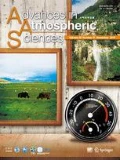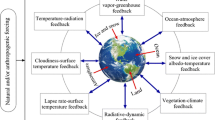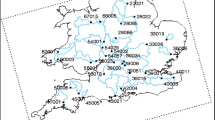Abstract
The simulation of hydrological consequences of climate change has received increasing attention from the hydrology and land-surface modelling communities. There have been many studies of climate-change effects on hydrology and water resources which usually consist of three steps: (1) use of general circulation models (GCMs) to provide future global climate scenarios under the effect of increasing greenhouse gases, (2) use of downscaling techniques (both nested regional climate models, RCMs, and statistical methods) for “downscaling” the GCM output to the scales compatible with hydrological models, and (3) use of hydrologic models to simulate the effects of climate change on hydrological regimes at various scales. Great progress has been achieved in all three steps during the past few years, however, large uncertainties still exist in every stage of such study. This paper first reviews the present achievements in this field and then discusses the challenges for future studies of the hydrological impacts of climate change.
Similar content being viewed by others
References
Alcamo, J., and T. Henrichs, 2002: Critical regions: A model-based estimation of world water resources sensitive to global changes.Aquatic Science,64, 352–362.
Arnell, N. W., 1999a: Global change and global water resources.Global Environmental Change,9, S31-S49.
Arnell, N. W., 1999b: A simple water balance model for the simulation of streamflow over a large geographic domain.J. Hydrol.,217, 314–335.
Arnell, N. W., 2004: Global change and global water resources: SRES emissions and socio-economic scenarios.Global Environmental Change,14, 31–52.
Arnell, N. W., and N.S. Reynard, 1996: The effects of climate change due to global warming on river flows in Great Britain.J. Hydrol.,183, 397–424.
Arora, V. K., 2001: Streamflow simulations for continentalscale river basins in a global atmospheric general circulation model.Advances in Water Resources,24, 775–791.
Arora, V. K., and G. J. Boer, 1999: A variable velocity flow routing algorithm for GCMs.J. Geophys. Res.,104, 30965–30979.
Boorman, D. B., and C. E. Sefton, 1997: Recognizing the uncertainty in the quantification of the effects of climate change on hydrological response.Climatic Change,35, 415–434.
Chen, F., and J. Dudhia, 2001: Coupling an advanced land surface-hydrology model with the Penn State-NCAR MM5 Modeling System. Part I: Model implementation and sensitivity.Mon. Wea. Rev.,129, 569–585.
Christensen, J., M. Hulme, H. von Storch, P. Whetton, R. Jones, L. Mearns, and C. Fu, 2001: Regional climate information—Evaluation and projections.Climate Change 2001: The Scientific Basis. Contribution of Working Group I to the Third Assessment Report of the Intergovernmental Panel on Climate Change, J. T. Houghton et al., Eds, Cambridge University Press, 583–638.
Cocke, S. D., and T. E. LaRow, 2000: Seasonal prediction using a regional spectral model embedded within a coupled ocean-atmosphere model.Mon. Wea. Rev.,128, 689–708.
Dolman, A. J., A. J. Hall, M. L. Kavvas, T. Oki, and J. W. Pomeroy, (Eds.), 2001:Soil-Vegetation-Atmosphere Transfer Schemes and Large-Scale Hydrological Models. IAHS Publ. No 270, 372pp.
Döll, P., F. Kaspar, and B. Lehner, 2003: A global hydrological model for deriving water availability indicators—Model tuning and validation.J. Hydrol.,270, 105–134.
Döll, P., and S. Siebert, 2001: Global modeling of irrigation water requirements.Water Resour. Res., 38(4), 10.1029/2001WR000355.
Dooge, J. C. I., and E. Kuusisto, (Eds), 1998: Climate and Water—A 1998 perspective. Report of the Second International Conf. on Climate and Water, Helsinki University of Technology, Helsinki, 48pp.
Engeland, K., L. Gottschalk, and L. Tallaksen, 2001: Estimation of regional parameters in a macro scale hydrological model.Nordic Hydrology,32, 161–180.
Fekete, B. M., C. J. Vörösmarty, J. O. Roads, and C. J. Willmott, 2004: Uncertainties in precipitation and their impacts on runoff estimates.J. Climate,17, 294–304.
Gerten, D., S. Schaphoff, U. Haberlandt, W. Lucht, and S. Sitch, 2004: Terrestrial vegetation and water balance—Hydrological evaluation of a dynamic global vegetation model.J. Hydrol.,286, 249–270.
Goodess, C., M. Hulme, and T. Osborn, 2001: The Identification and Evaluation of Suitable Scenario Development Methods for the Estimation of Future Probabilities of Extreme Weather Events, Working Paper 6, Tyndall Centre for Climate Change Research, Norwich, U. K., 44pp.
Graham, L. P., 2004: Climate change effects on river flow to the Baltic Sea.AMBIO,33, 235–241.
Graham, L. P., and D. Jacob, 2000: Using large-scale hydrologic modelling to review runoff generation processes in GCM climate models.Meteorologische Zeitschrift,9, 49–57.
Graham, L. P., and S. Bergstrom, 2001: Water balance modelling in the Baltic Sea drainage basin —analysis of meteorological and hydrological approaches.Meteorology and Atmospheric Physics,77, 45–60.
Hagemann, S., and L. Dümenil, 1998: A parameterization of the lateral waterflow for the global scale.Climate Dyn.,14, 17–31.
Hay, L. E., M. P. Clark, R. L. Wilby, W. J. Gutowski, G. H. Leavesley, Z. Pan, R. W. Arritt, and E. S. Takle, 2002: Use of regional climate model output for hydrologic simulations.Journal of Hydrometeorology,3(5), 571–590.
Hellström, C., and D. Chen, 2003: Statistical downscaling based on dynamically downscaled predictors: Application to monthly precipitation in Sweden.Adv. Atmos. Sci.,20, 951–958.
Hulme, M., and Carter, T., 1999: Representing Uncertainty in Climate Change Scenarios and Impact Studies.Representing Uncertainty in Climate Change Scenarios and Impact Studies. Proc. ECLAT-2 Helsinki Workshop, Carter, T. R., Hulme, M., and Viner, D. Eds., Finland, Climatic Research Unit, Norwich, U.K, 11–37
IPCC, 1996:Climate Change 1995: The Science of Climate Change.Contribution of Working Group I to the Second Assessment Report of the Intergovernmental Panel on Climate Change, J. T. Houghton et al., Eds., Cambridge University Press, Cambridge and New York, 572pp
IPCC, 2001:Third Assessment Report — Climate Change 2001. IPCC/WMO/UNEP.
Kilsby, C. G., P. S. P. Cowpertwait, P. E. O’Connell, and P. D. Jones, 1998: Predicting rainfall statistics in england and Wales using atmospheric circulation variables.International Journal of Climatology,18, 523–539.
Kim, W., T. Arai, S. Kanae, T. Oki, and K. Musiake, 2001: Application of the Simple Biosphere Model (SiB2) to a paddy field for a period of growing season in GAME-Tropics.J. Meteor. Soc. Japan.,79(1B), 387–400.
Klemes, V., 1986: Operational testing of hydrological simulation.Hydrological Sciences Journal,31, 13–24.
Kucharik, C. J., and Coauthors, 2000: Testing the performance of a Dynamic Global Ecosystem Model: Water balance, carbon balance, and vegetation structure.Global Biogeochemical Cycles,14, 795–825.
Kunkel, R., and F. Wendland, 2002: The GROWA98 model for water balance analysis in large river basins—The river Elbe case study.J. Hydrol.,259, 152–162.
Leavesley, G. H., 1994: Modelling the effects of climate change on water resources —A review.Climatic Change,28, 159–177.
Ledoux, E., P. Etchevers, C. Golaz, F. Habets, J. Noilhan, and S. Voirin, 2002: Regional simulation of the water budget and riverflows with the ISBA-Modcou coupled model. Application to the Adour and Rhone Basins.Mathematical Models of Large Watershed Hydrology, V. P. Singh and D. K. Frevert, Eds, Water Resources Publication, LLC Colorado, 283–318.
Liang, X., D. P. Lettenmaier, E. Wood, and S. J. Burges, 1994: A simple hydrologically based model of landsurface water and energy fluxes for general circulation models.J. Geophys. Res.,99(D7), 14415–14428.
Loaiciga, H. A., J. B. Valdes, R. Vogel, J. Garvey, and H. Schwarz, 1996: Global warming and the hydrologic cycle.J. Hydrol.,174, 83–127.
Ma, X., Y. Fukushima, T. Hiyama, T. Hashimoto, and T. Ohata, 2000: A macro-scale hydrological analysis of the Lena River basin.Hydrological Processes,14, 639–651.
Maidment, D. R., 1996: GIS and hydrologic modelling—An assessment of progress.The Third International Conference on GIS and Environmental Modeling, 22-26 January, Santa Fe, New Mexico. National Center for Geographic Information and Analysis, Santa Barbara, California, 1 CD-ROM.
Miller, J. R., G. L. Russell, and G. Caliri, 1994: Continental-scale river flow in climate models.J. Climate,7, 914–928.
Müller-Wohlfeil, D-I., G. Bürger, and W. Lahmer, 2000: Response of a river catchment to climatic change: Application of expanded downscaling to northern germany.Climatic Change,47, 67–89.
Nemec, J., and J. Schaake, 1982: Sensitivity of water resources system to climate variation.Hydrological Sciences Journal,2, 327–343.
Ohfuchi, W., and Coauthors, 2004: 10-km mesh mesoscale resolving simulations of the global atmosphere on the Earth Simulator—Preliminary outcomes of AFES (AGCM for the Earth Simulator).Journal of the Earth Simulator,1, 8–34.
Oki, T., T. Nishimura, and P. Dirmeyer, 1999: Assessment of annual runoff from land surface models using Total Runoff Integrating Pathways (TRIP).J. Meteor. Soc. Japan,77, 235–255.
Rummukainen, M., J. Räisänen, B. Bringfelt, A. Ullerstig, A. Omstedt, U. Willen, U. Hansson, and C. Jones, 2001: A regional climate model for northern Europe: Model description and results from the downscaling of two GCM control simulations.Climate Dyn.,17, 339–359.
Rummukainen, M., S. Bergstrom, G. Persson, J. Rodhe, and M. Tjernström, 2004: The Swedish Regional Climate Modelling Programme, SWECLIM: A review.Ambio,33, 176–182.
Samuelsson, P., B. Bringfelt, and L. P. Graham, 2003: The role of aerodynamic roughness for runoff and snow evaporation in land-surface schemes—Comparison of uncoupled and coupled simulations.Global and Planetary Change,38, 93–99.
Schulze, R. E., 1997: Impacts of global climate change in a hydrologically vulnerable region: challenges to South African hydrologists.Progress in Physical Geography,21, 113–36.
Singh, V. P., and D. Frevert, (Eds.), 2002:Mathematical Models of Large Watershed Hydrology. Water Resources Publications LLC, Colorado, 891pp.
Stehlik, J., and A. Bardossy, 2002. Multivariate stochastic downscaling model for generating daily precipitation series based on atmospheric circulation.J. Hydrol.,256, 120–141.
Varis, O., T. Kajander, and R. Lemmela, 2004: Climate and water: From climate models to water resources management and vice versa.Climatic Change,66, 321–344.
von Storch, H., H. Langenberg, and F. Feser, 2000: A spectral nudging technique for dynamical downscaling purposes.Mon. Wea. Rev.,128, 3664–3673.
Vörösmarty, C. J., P. Green, J. Salisbury, and R. B. Lammers, 2000: Global water resources: Vulnerability from climate change and population growth.Science,289, 284–288.
Wetterhall, F., S. Halldin, and C.-Y. Xu, 2005a: Statistical precipitation downscaling in central Sweden with the Analogue Method.J. Hydrol.,306, 174–190.
Wetterhall, F., S. Halldin, and C.-Y. Xu, 2005b: Seasonality properties of four statistical-downscaling methods in central Sweden.Theoretical and Applied Climatology. (In press)
Wilby, R. L., L. E. Hay, W. J. Gutowski, R. W. Arritt, E. S. Takle, Z. Pan, G. H. Leavesley, and M. P. Clark, 2000: Hydrological responses to dynamically and statistically downscaled climate model output.Geophys. Res. Lett.,27, 1199–1202.
Wilby, R. L., and T. M. L. Wigley, 1997: Downscaling general circulation model output: A review of methods and limitations.Progress in Physical Geography,21, 530–548.
Wood, E. F., D. Lettenmaier, X. Liang, B. Nijssen, and S. W. Wetzel, 1997: Hydrological modeling of continental-scale basins.Annual Review of Earth and Planetary Sciences,25, 279–300.
Xu, C.-Y., 1999a: From GCMs to river flow: A review of downscaling techniques and hydrologic modeling approaches.Progress in Physical Geography,23, 229–249.
Xu, C.-Y., 1999b: Operational testing of a water balance model for predicting climate change impacts.Agricultural and Forest Meteorology,98-99(1–4), 295–304.
Xu, C.-Y., 2000: Modelling the effects of climate change on water resources in central Sweden.Water Resources Management,14, 177–189.
Xu, C.-Y., and V. P. Singh, 2004: Review on regional water resources assessment under stationary and changing climate.Water Resources Management,18(6), 591–612.
Author information
Authors and Affiliations
Corresponding author
Rights and permissions
About this article
Cite this article
Xu, Cy., Widén, E. & Halldin, S. Modelling hydrological consequences of climate change—Progress and challenges. Adv. Atmos. Sci. 22, 789–797 (2005). https://doi.org/10.1007/BF02918679
Received:
Revised:
Issue Date:
DOI: https://doi.org/10.1007/BF02918679




